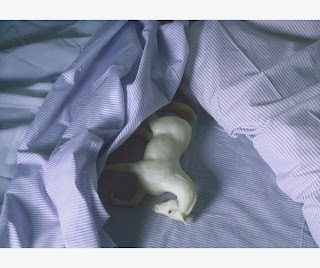As you star in your own performances, how important is your own presence/personality to these performances, is it related to the messages you are trying to convey?
I am constantly surprised by each visiting artist. Just when I think I know what to expect I find out I had no idea. Alexandre Singh's work isn't something you can just read about or see pictures of, it is something you must experience. I am very fortunate to have seen him present his art because I feel like without this opportunity I would not have been interested in his art. The presentation, for lack of a better word, was fascinating because I knew I was being manipulated from the beginning, I knew I shouldn't believe everything I heard, but I felt like I didn't have any control over what was happening to me. That was art like I have never experienced. Singh helped me put in to perspective that there are things that I can't make sense of, no matter how much sense they should make.
My first question was answered but my second one I am still kind of curious about. His work didn't seem to be very personal or emotionally based which is sometimes hard for me to relate to, but I did see connections with his world travels and diverse background. I don't think lack of personal connections is important to work like his though. To me, Singh's work had a lot to do with education, his past education, his continuing education through his art, and his education of his viewers. Singh's work is observant and ask us to be observant back.
I am constantly surprised by each visiting artist. Just when I think I know what to expect I find out I had no idea. Alexandre Singh's work isn't something you can just read about or see pictures of, it is something you must experience. I am very fortunate to have seen him present his art because I feel like without this opportunity I would not have been interested in his art. The presentation, for lack of a better word, was fascinating because I knew I was being manipulated from the beginning, I knew I shouldn't believe everything I heard, but I felt like I didn't have any control over what was happening to me. That was art like I have never experienced. Singh helped me put in to perspective that there are things that I can't make sense of, no matter how much sense they should make.
My first question was answered but my second one I am still kind of curious about. His work didn't seem to be very personal or emotionally based which is sometimes hard for me to relate to, but I did see connections with his world travels and diverse background. I don't think lack of personal connections is important to work like his though. To me, Singh's work had a lot to do with education, his past education, his continuing education through his art, and his education of his viewers. Singh's work is observant and ask us to be observant back.























